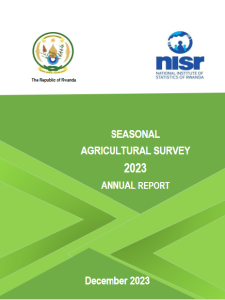
Seasonal Agricultural Survey -2023 Annual Report
National Institute of Statistics of Rwanda (NISR) has conducted the seasonal agricultural survey for the agricultural year 2022/2023, which covers three primary agricultural seasons in Rwanda. The main agricultural seasons include Season A, spanned from September 2022 to February 2023, Season B which started from March to June 2023, and Season C which started from July to September 2023. The survey covered 1,200 segments and 345 large scale farmers across the country.
The total country land area is estimated at 2.377 million of hectares for which 1.367 million hectares (57.5% of total country land) is used for agriculture. In 2023 Season A, 1 million hectares were used for Seasonal crops, 0.5 million hectares were covered by permanent crops, while 0.126 million hectares were used for permanent pasture. Likewise, in season B, the total country land area is estimated at 2.377 million of hectares for which 1.345 million hectares (56.6% of total country land) is used for agriculture. In addition, 983,000 hectares were used for seasonal crops, 540,000 hectares were covered by permanent crops, while 124,000 hectares were used for permanent pasture.
Commonly used agricultural inputs include improved seeds, organic and chemical fertilizers, as well as pesticides/fungicides. The 2023 results indicate that 37.1 percent of farmers in season A, 20.8 percent in season B, and 20.7 percent in season C used improved seeds. In season A, 87.9 percent of farmers applied organic fertilizer, 83.4 percent in season B, and 83.7 percent applied organic fertilizers in season C. In addition, 59.6 percent of famers applied inorganic fertilizer in season A, 51.6 percent of famers applied inorganic fertilizer in season B while 74.5 percent in season C. In regard to use of pesticides, in season A of 2023, 34.5 percent of farmers applied pesticides in season A, 29.7 percent in season B and 69.3 percent in season C.
In season A of 2023, 10.3 percent of farmers practiced irrigation compared to 9.6 percent of farmers in season B and 64.6 percent in season C. In 2023 Season A, 92.1 percent of farmers practiced anti-erosion activities, compared to 91.6 percent of farmers in season B and 94.8 percent of farmers in season C.
| File | Download Count |
|---|---|
| 416 | |
| 195 |
